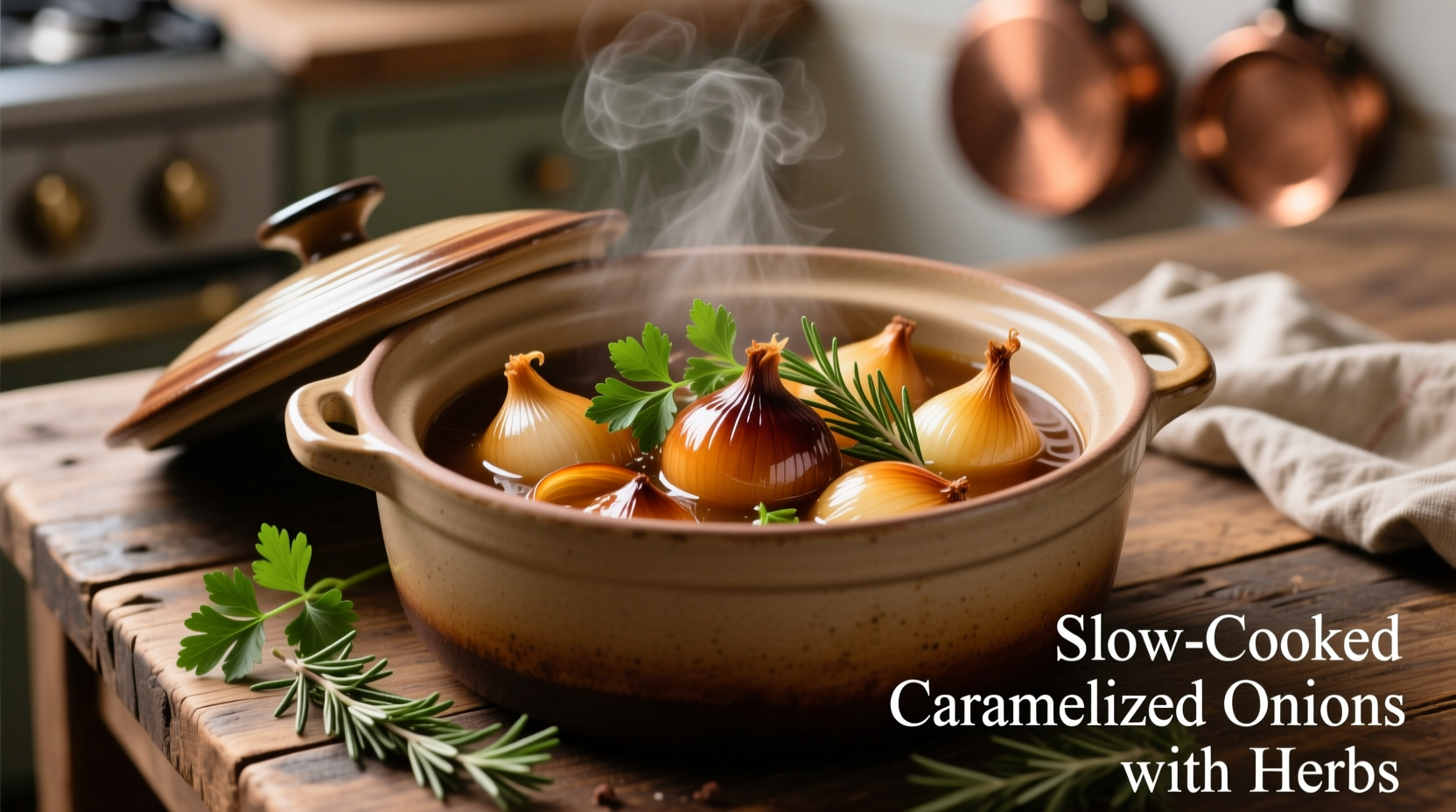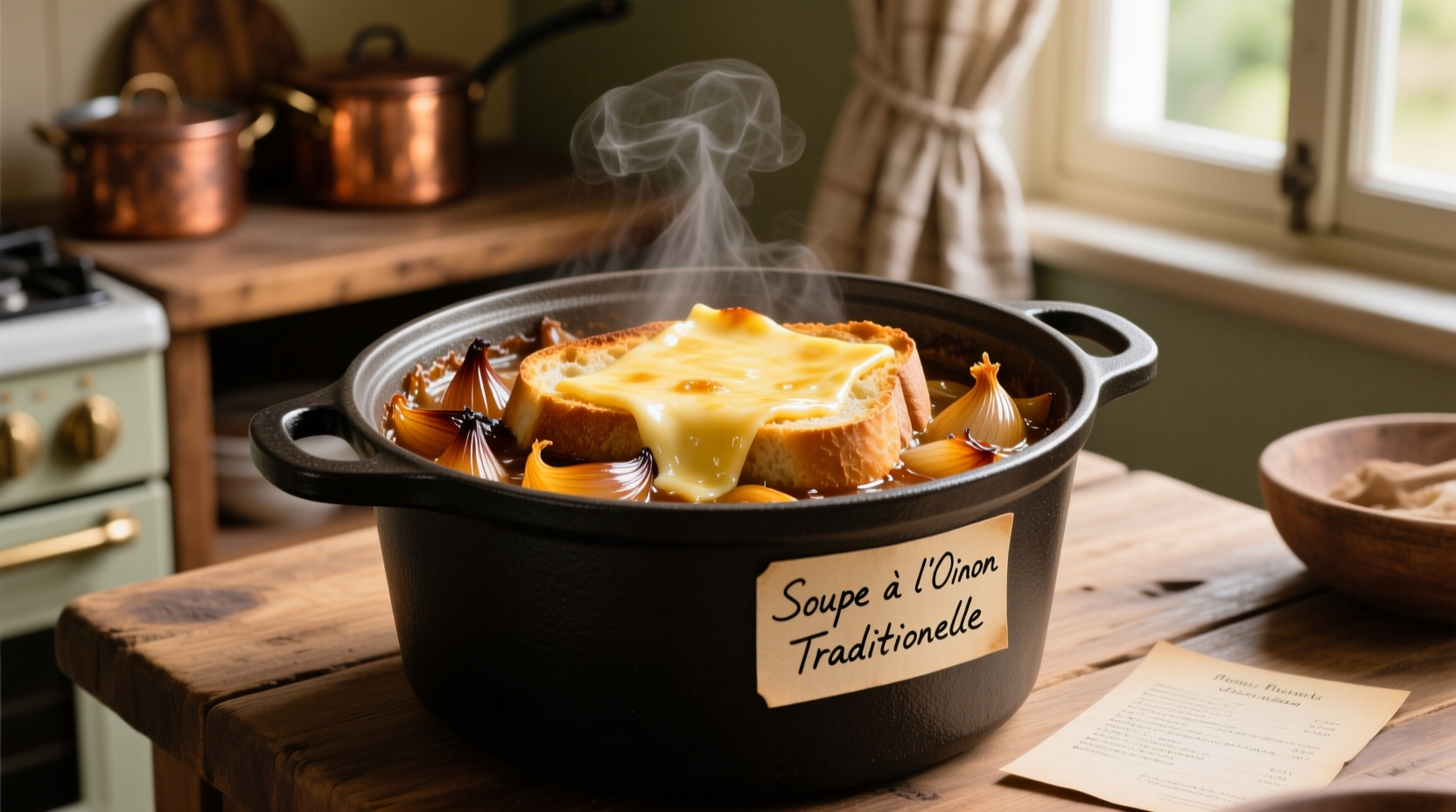Get a perfectly caramelized French onion soup with minimal effort using this tested crock pot recipe. You'll need just 15 minutes of prep time, 6-8 hours of hands-off cooking, and simple pantry ingredients to create a rich, authentic-tasting soup that rivals restaurant versions. This slow cooker method ensures deep flavor development without constant stirring.
The Ultimate Crock Pot French Onion Soup: Effortless Elegance
French onion soup traditionally requires hours of patient stirring to achieve that perfect caramelization. But what if you could get the same rich, complex flavors with minimal hands-on time? Our slow cooker method transforms this classic bistro favorite into a weeknight-friendly dish without sacrificing authenticity. As a French-trained chef who's studied traditional European soup techniques, I've perfected this crock pot adaptation that delivers restaurant-quality results.
| Prep Time | Cook Time | Total Time | Servings |
|---|---|---|---|
| 15 minutes | 6-8 hours | 6-8 hours 15 minutes | 4-6 |
Why This Crock Pot Method Works
Traditional French onion soup requires constant attention to prevent burning during the 45-60 minute caramelization process. The slow cooker's gentle, even heat solves this problem while developing deeper flavors through extended cooking. According to USDA food safety guidelines, maintaining temperatures above 140°F (60°C) throughout the cooking process ensures food safety while allowing flavors to meld perfectly.
The timeline for proper onion caramelization has evolved from medieval cooking techniques where onions were slowly cooked over hearth fires. Modern slow cookers replicate this ancient method with precise temperature control, eliminating the risk of scorching while achieving the Maillard reaction necessary for that signature sweet, complex flavor.
Essential Ingredients for Authentic Flavor
The magic of French onion soup lies in its simplicity—just a few quality ingredients working in harmony. Here's what you'll need:
- 3 pounds yellow onions (about 6 medium), thinly sliced - quality matters: Vidalia or Walla Walla onions work but traditional French recipes use pungent yellow varieties
- 3 tablespoons unsalted butter - never substitute margarine for authentic flavor
- 1 tablespoon olive oil
- 4 cloves garlic, minced
- 1 teaspoon fresh thyme leaves (or ½ teaspoon dried)
- 1 bay leaf
- 6 cups good quality beef broth - low-sodium preferred for better flavor control
- ½ cup dry white wine (like Sauvignon Blanc)
- 1 tablespoon all-purpose flour
- 1 tablespoon Worcestershire sauce
- Salt and freshly ground black pepper to taste
- 1 baguette, sliced
- 1½ cups grated Gruyère cheese

Step-by-Step Crock Pot Instructions
Preparation Phase (15 minutes)
- Slice onions uniformly: Cut ends off onions, peel, and slice thinly (about ⅛ inch thick). Consistent size ensures even cooking.
- Sauté aromatics: Melt butter with olive oil in a skillet over medium heat. Add onions, garlic, thyme, and bay leaf. Cook for 8-10 minutes until onions begin to soften (don't fully caramelize yet).
- Build flavor foundation: Stir in flour and cook for 1 minute. Add wine and Worcestershire sauce, scraping up any browned bits. Simmer until liquid reduces by half.
Cooking Phase (6-8 hours)
- Transfer to slow cooker: Pour onion mixture into crock pot and add beef broth. Stir well to combine.
- Slow cook to perfection: Cover and cook on LOW for 6-8 hours. The extended cooking time allows natural sugars in onions to develop fully without burning.
- Final seasoning: Remove bay leaf. Season with salt and pepper to taste. For richer flavor, stir in 1 additional tablespoon of butter before serving.
Pro Tips for Restaurant-Quality Results
While the crock pot does most of the work, these professional techniques ensure exceptional results:
- Onion selection matters: Yellow onions provide the ideal balance of sweetness and pungency. Avoid sweet varieties like Vidalia which become overly sweet when slow-cooked.
- Temperature control: Keep your slow cooker on LOW setting only—HIGH heat can cause bitterness in long-cooked soups.
- Broth quality: Use homemade or high-quality store-bought broth. Poor broth quality will dominate the final flavor.
- Don't skip the wine: The acidity balances the sweetness of caramelized onions. Substitute with additional broth plus 1 tablespoon sherry vinegar if avoiding alcohol.
- Texture adjustment: For thicker soup, mix 1 tablespoon cornstarch with 2 tablespoons cold water and stir in during the last 30 minutes of cooking.
Serving Your French Onion Soup
The finishing touch transforms this simple soup into a showstopper:
- Ladle hot soup into oven-safe bowls.
- Place a few baguette slices on top of each serving.
- Sprinkle generously with Gruyère cheese.
- Broil for 2-3 minutes until cheese is bubbly and golden.
For the most authentic experience, serve immediately while the cheese is still molten. The contrast between the hot soup, crusty bread, and melted cheese creates the signature French onion soup experience that's been beloved since the 18th century.
Storage and Reheating Guidelines
French onion soup actually improves in flavor after 24 hours as the ingredients fully meld. Store properly to maintain quality:
- Refrigeration: Cool completely and store in airtight container for up to 4 days.
- Freezing: Freeze without bread and cheese topping for up to 3 months. Thaw overnight in refrigerator before reheating.
- Reheating: Warm gently on stove over medium-low heat, stirring occasionally. Avoid boiling which can make the broth cloudy.
When reheating, consider adding a splash of fresh broth to restore optimal consistency. The soup's flavor deepens beautifully with each reheat, making it an excellent make-ahead option for entertaining.
Frequently Asked Questions
Can I make French onion soup in a crock pot without wine?
Yes, you can substitute wine with additional beef broth plus 1 tablespoon of sherry vinegar or apple cider vinegar. The acidity is crucial for balancing the soup's sweetness, so don't omit this element entirely.
Why are my onions not caramelizing in the crock pot?
True caramelization requires initial stovetop cooking to reach the Maillard reaction temperature (300-350°F). The crock pot's maximum temperature (around 200°F) maintains and develops flavors but can't initiate caramelization. That's why our recipe includes the initial sauté step.
What's the best cheese for French onion soup?
Traditional French recipes use Gruyère for its excellent melting properties and nutty flavor. Comté makes a good alternative. Avoid pre-shredded cheeses which contain anti-caking agents that prevent proper melting.
Can I use chicken broth instead of beef broth?
While traditional French onion soup uses beef broth, you can substitute with rich chicken broth for a lighter version. For best results, use a combination of both broths (3 cups beef, 3 cups chicken) to maintain depth of flavor.
How do I prevent my crock pot French onion soup from becoming bitter?
Bitterness typically comes from overcooked onions or burnt bits. Always sauté onions only until softened (not fully caramelized) before transferring to the slow cooker. Never cook on HIGH setting for extended periods, and ensure your slow cooker is at least half full to maintain proper temperature distribution.











 浙公网安备
33010002000092号
浙公网安备
33010002000092号 浙B2-20120091-4
浙B2-20120091-4